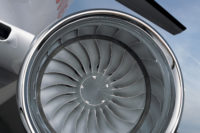FARNBOROUGH, England—Rolls-Royce engineers are developing miniature robots that could be used in future jet engine maintenance applications.
The IntelligentEngine initiative is studying a wide variety of advanced robotic technology, ranging from snake robots that work their way through the engine like an endoscope, to miniature, collaborative swarm robots that crawl through the insides of an engine.
“These robotic technologies each represent an opportunity to improve the way engine maintenance is delivered,” says James Kell, on-wing technology specialist at Rolls-Royce. “[Potential applications include] speeding up inspection processes or removing the need to take an engine off an aircraft to perform maintenance work.
“This has the potential to offer significant benefits for customers by reducing the cost of engine maintenance, increasing the availability of an engine, and ensuring any maintenance required is completed as quickly as possible,” explains Kell.
Four technologies are being developed with engineers at Harvard University and the University of Nottingham, including:
*SWARM robots. A set of collaborative, miniature robots, each around 10 millimeters in diameter, would be deposited in the center of an engine via a snake robot. They would perform a visual inspection of hard-to-reach areas by crawling through the engine. These robots would carry small cameras that provide live video feed to the operator, allowing them to complete a rapid visual inspection of the engine without having to remove it from the aircraft.
*INSPECT robots. A network of “periscopes” permanently embedded within an engine would use cameras to spot and report any maintenance requirements. These pencil-sized robots would be thermally protected from the extreme heat generated within an engine. The visual data they create would be used alongside the millions of data points already generated by today’s engines as part of their health monitoring systems.
*Remote bore-blending robots. This robotic machine would be remotely controlled by engineers. It would perform complex maintenance tasks, such as repairing damaged compressor blades using lasers to grind parts. This would remove the need for specialist teams to travel to the location of an aircraft needing maintenance, vastly reducing the time required to return it to service.
*FLARE. A pair of snake robots would be flexible enough to travel through an engine, like an endoscope, before collaborating to carrying out patch repairs to damaged thermal barrier coatings.
“While some of these technologies, such as the SWARM robots, are still a long way from becoming an everyday reality, others, such as the remote bore-blending robot, are already being tested and will begin to be introduced over the next few years,” says Kell. “This is an area with the potential to revolutionize how we think about engine maintenance.”


